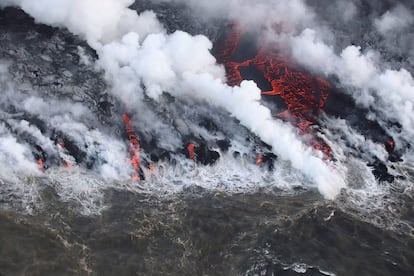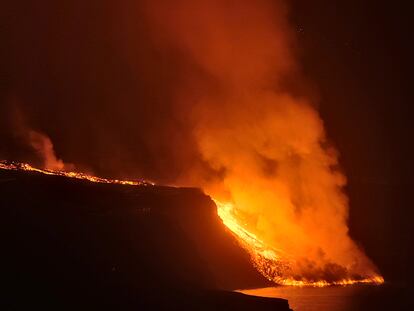Volcanic eruption in La Palma: What happens when lava enters the sea?
Studies show that while these events can dramatically change coastal conditions, the effects are transitory: systems can recover within two years

The lava flow from the La Palma volcano, in Spain’s Canary Islands, is a bomb for the sea. It’s not just because of the explosions created by the hydrothermal and chemical reactions, but also because it will dramatically change the coastline conditions.
Yet the effect will be transitory. Scientific studies on similar phenomena show that marine life recovers quickly and efficiently following an accumulation of lava. Some research has shown normal levels two years after the event. An expedition from the Spanish Oceanographic Institute (IOE) will study the geological effects on the coast as well as the physical, chemical and biological consequences, explained Tomás Vázquez, a marine geologist who works for the IOE.
The temporary rise in temperature is very harmful to species that are used to a very specified range of temperaturesTomás Vázquez, marine geologist
The first reaction is thermal. Tons of rock with a temperature of over 1,000ºC are falling into a body of water where the average temperature is 23ºC. The second reaction, which comes immediately after the first, is chemical and involves the contact between the components of the lava, the water and the sea salts made of sodium chloride. Raúl Pérez, a geologist, seismologist and researcher at the Geology and Mining Institute of Spain (IGME) who is part of the team monitoring the eruption of the Cabeza de Vaca volcano in La Palma, explained these effects: “There is a spectacular plume of steam, but there can be collapses due to an accumulation of the lava front, and this interaction with the water can lead to explosions. It’s not like a fountain of chocolate falling on water.”
In order to know the long-term consequences of this contact between the lava and the sea, it is useful to look at past research on similar events. The most recent one was conducted by the IEO when there was a submarine eruption in the nearby island of El Hierro from October 2010 to March 2011. That eruption created a large amount of magma and gases, but, as Tomás Vázquez noted, the interaction with the water was immediate, while in the case of La Palma, this contact is not directly with the seabed but with the more superficial layers of the sea.
The water conditions will change substantially: the temperature and acidity will rise as a result of emissions of carbon dioxide, carbonic acid and sulfuric acid. The IEO geologist noted that in the case of El Hierro, these alterations were quite significant because “all the gas emissions were underwater.”
There will also be alterations to the concentration of metals such as iron, copper, cadmium and mercury, as well as an increase in carbon dioxide emissions and a reduction in oxygen – in El Hierro, this reduction was nearly absolute according to some measurements. Levels are not expected to be the same in La Palma, where the lava is dropping down into the sea from a cliff. Mario Lebrato, of the Geosciences Institute at Kiel University in Germany, said that “these fluids do not react the same way as in deep water systems.”
The El Hierro study revealed “various responses by marine organisms.” Research on this and other, similar eruptions reflected the proliferation of phytoplankton (microorganisms that obtain their energy from photosynthesis and live in the water) that make the most of the increased levels of nutrients and can survive high temperatures and metal concentrations.
The water conditions will change substantially: the temperature and acidity will rise as a result of emissions of carbon dioxide, carbonic acid and sulfuric acid
In a study published in the journal Science, Samuel Wilson looked at the impact of the entry of lava into the sea following the eruption of Kīlauea volcano in Hawaii in 2018, and found that this event fueled large phytoplankton blooms in nearby waters. These lasted during the two-month-long eruption and rapidly dissipated when the lava stopped flowing. The cause, according to Wilson, was the “unexpectedly high concentrations of nitrate and rise in temperatures.”
Changes in the environment due to the entry of lava can also push species to temporarily flee the area until the sea returns to its normal levels, while a rise in water acidity can lead to the death of marine life. Tomás Vázquez added that “the temporary rise in temperature is very harmful to species that are used to a very specified range of temperatures.” He explained: “Some try to flee before the lava arrives, as soon as they detect that the water temperature is changing.”
In the El Hierro study, the Biodiversity, Marine Ecology and Conservation (Bioecomac) research team detected sediments of ash and substances from the sulfur that were brought in by the tide and storms; the appearance of new organisms; transitory changes in the species of dominant algae and a rise in mollusks and invertebrates whose larvae survived the temporary changes and benefited from the drop in predatory pressure from fish that had left the area or died. When the sea conditions improved, the fish returned and took advantage of the greater plankton numbers.
The geologist from the IOE said that researchers will also look at how the lava affects benthon, the organisms that live near the sea bottom. “These always take a bit longer to repopulate, but for planktonic organisms, it will be easier to colonize the area again.”
The Bioecomac group proposed a closed season in the area of El Hierro to help the recovery. Tomás Vázquez said that such a move could also be advisable in La Palma for the regeneration of life in the area, until levels go back to normal.
Recovery times are uncertain, but there is cause for optimism. A 10-year study on an area affected by a volcano and published in Scientific Reports concluded that “the sudden and catastrophic changes observed [...] profoundly reshaped biogeochemical processes in shallow and offshore waters for one year, but they remained transient in nature, with a possible recovery of the system within two years.”
English version by Susana Urra and Melissa Kitson.
Tu suscripción se está usando en otro dispositivo
¿Quieres añadir otro usuario a tu suscripción?
Si continúas leyendo en este dispositivo, no se podrá leer en el otro.
FlechaTu suscripción se está usando en otro dispositivo y solo puedes acceder a EL PAÍS desde un dispositivo a la vez.
Si quieres compartir tu cuenta, cambia tu suscripción a la modalidad Premium, así podrás añadir otro usuario. Cada uno accederá con su propia cuenta de email, lo que os permitirá personalizar vuestra experiencia en EL PAÍS.
¿Tienes una suscripción de empresa? Accede aquí para contratar más cuentas.
En el caso de no saber quién está usando tu cuenta, te recomendamos cambiar tu contraseña aquí.
Si decides continuar compartiendo tu cuenta, este mensaje se mostrará en tu dispositivo y en el de la otra persona que está usando tu cuenta de forma indefinida, afectando a tu experiencia de lectura. Puedes consultar aquí los términos y condiciones de la suscripción digital.
More information
Últimas noticias
Most viewed
- Reinhard Genzel, Nobel laureate in physics: ‘One-minute videos will never give you the truth’
- Oona Chaplin: ‘I told James Cameron that I was living in a treehouse and starting a permaculture project with a friend’
- Pablo Escobar’s hippos: A serious environmental problem, 40 years on
- Why we lost the habit of sleeping in two segments and how that changed our sense of time
- Chevy Chase, the beloved comedian who was a monster off camera: ‘Not everyone hated him, just the people who’ve worked with him’











































